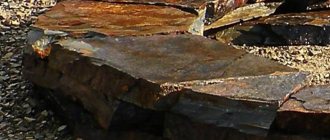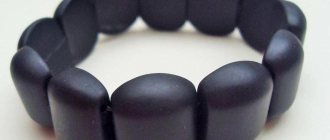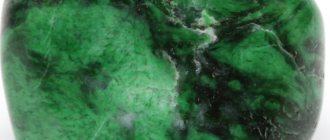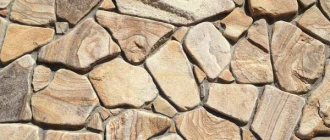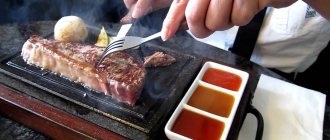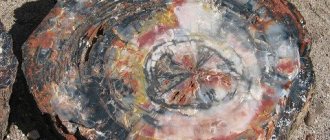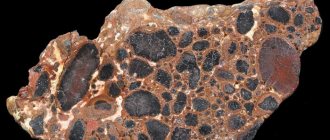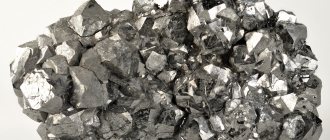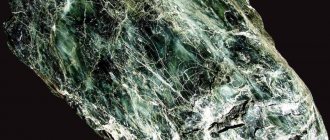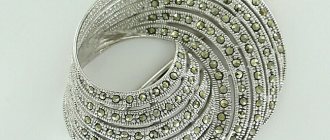Lepidocrocite–goethite group
Synonym: “needle iron ore” (in German literature). It is the main component of such a heterogeneous, but widespread and well-known mineral formation as limonite (hydrogoethite)
Limonite is not a mineral of a strictly defined composition, but is a mixture of various iron hydroxides called brown iron ore.
origin of name
Goethite is named after the poet Goethe (1749–1832). Initially, this mineral was called onegite (based on its location on Volk'island in Lake Onega), but since its properties were not described, this name did not take root in the mineralogical literature.
The name limonite comes from the Greek word lemon - meadow (meaning meadow and swamp ores of iron hydroxides).
Limonite. Large spherulite. Pisolite
Origin
The term limonite refers to a set of minerals representing a mixture of hydrated iron oxides with other components in the composition.
The age of the deposits is estimated at 24-25 million years.
The history of its formation is not fully understood. Three concepts have been developed:
- Raw materials are formed in regions with conditions for intense oxidation of iron ore deposits reaching the surface.
- The surface layers of iron ores are constantly moistened.
- Microorganisms (bacteria) are involved in the formation of the mineral. This concept seems exotic and has not yet been proven.
The mineral is also mentioned in the literature as brown iron ore and bog ore. This directly indicates the conditions of formation.
The name of the mineral goes back to the ancient Greek λειμων - “meadow”.
Place of Birth
Of the very numerous and genetically diverse deposits of brown iron ore, we will indicate only some of the most important.
Within Russia, the well-known Bakal deposit of brown iron ores (Southern Urals, southwest of Zlatoust) was formed in the form of large iron hats as a result of the oxidation of crystalline siderite ores, apparently of hydrothermal origin. Along with soft, friable ores, brown iron ore geodes, often very large, are widespread. The walls of the cavities are covered with buds of limonite and goethite. These ores are low-phosphorus and of high quality. The Khalilovskoye deposit of brown iron ores (near the Khalilovo railway station, Orenburg region, Southern Urals) was formed in the Jurassic period due to weathering and erosion of massifs of ultrabasic (serpentinite) rocks. Therefore, brown iron ores are somewhat enriched in elements such as nickel and chromium, which are valuable alloying components of steels. Nickel-bearing brown iron ores as residual products of weathering of serpentinites are widespread in the Urals; Let's call the Elizavetinskoye field near Yekaterinburg. A large deposit of predominantly large-olitic brown iron ores is located on the Kerch Peninsula . A thick ore layer occurs in troughs among sediments of Tertiary age. These ores contain 34–42% Fe and are enriched in phosphorus. Deposits similar in composition to ores, but of a noticeably smaller scale, are found nearby on the Taman Peninsula . Brown iron ores are represented by the ores of Alsace (France).
Physico-chemical characteristics
According to the chemical and geological classification, the mineral limonite is an iron oxide of sedimentary origin. It is supplemented by lepidocrocites, goethites, and water.
The formula is complicated by the presence of metal oxides (nickel, titanium, chromium, phosphorus), clay components, and residues of organic compounds.
| Formula | FeOOH (Fe2O3 nH2O) |
| Color | Brown, black, ocher-yellow |
| Stroke color | Yellow, rusty brown |
| Shine | Matte |
| Transparency | Transparent, translucent, opaque |
| Hardness | 1,5 — 5,5 |
| Kink | earthy |
| Density | 3.3—3.9 g/cm³ |
| singonia | Rhombic |
The composition of the stone is variable, which reflects the variation in density on the Mohs scale - from 1.5 to 5.5.
Price of products
Limonite is affordable, so anyone can buy it. Depending on the quality of the stone, as well as the size and type of product, the price varies within:
- 0.15-0.2 $ - for tumbling 10-20 mm in size;
- from $2 - for a stone processed with a cabochon measuring 30 mm or more;
- 10-30 $ - for an intergrowth of limonite with rock crystal;
- $15 – for earrings in silver with a stone up to 30 mm;
- from $30 per bracelet depending on the size of the stones.
Jewelry with high-quality gemstones is more expensive. Their price is $250 and above.
Mining locations
Stone deposits are formed where there is a lot of mineralized water: swamps, shores, the bottom of seas, rivers, lakes.
Large deposits in Russia are Western Siberia, the Urals, Karelia, Bashkortostan, Tomsk, Lipetsk regions. KMA is rich in the ocher variety of raw materials.
The stone is also mined in France, India, Madagascar, Brazil, Venezuela, and Congo.
Medicinal properties
Amethyst pendant with limonite inclusions
Lithotherapists believe that regular use of limonite helps normalize the psycho-emotional state. The energy of the stone helps:
- reduce the manifestation of nervous disorders;
- normalize sleep;
- eliminate the manifestation of aggression, irritability, unreasonable fears;
- increase stress resistance;
- get rid of apathy and pessimistic attitude.
The properties of the gem also help strengthen the immune system, improve blood circulation and the functioning of the vascular system, normalize blood pressure, and increase hemoglobin levels.
Where is it used?
The mineral is in demand for practical and aesthetic purposes.
The scope of application is determined by the conditions of the raw materials:
- The enriched material, purified from impurities, is used in metallurgy for the smelting of cast iron, steel, and alloys.
- Yellow ocher is in demand in the chemical and paint industries. This is the source material for making paints.
- Limonite inserts add uniqueness to jewelry. The gem in silver is especially good.
The color range and moderate shine of the stone make it possible to create a line that is suitable for men (cufflinks, rings, rings, key rings).
- Stone cutters turn out interior items and esoteric assortments (candelabra, balls, pyramids).
Collectors of mineral collections have a great demand for combined samples - limonite on pyrite, marcasite, quartz.
Types of stone
Depending on the composition and density, two types of limonite are distinguished:
- “Glass brown head” - round growths that are smooth to the touch, thereby resembling a head and are distinguished by a silky shine and brown color.
- “Yellow Ocher” is a brittle yellow-orange mineral that easily grinds into powder. It is widely used among artists as a source of natural paints.
Based on color, limonites are divided into the following subspecies:
- lemon yellow;
- yellow-ochre;
- gray-brown;
- dark brown;
- orange-brown.
How to care for stone
Limonite in rock crystal
Limonite should be treated with care so that it retains its original beauty and color for a long time. To do this, it is recommended to follow simple rules:
- Designate a separate place for storing limonite. This could be a small box with soft upholstery inside, a case or a velvet bag.
- Remove jewelry with a gem while playing sports, taking a shower or bath, visiting a pool, sauna or bathhouse.
- Avoid exposure to mechanical factors and sudden temperature changes. The stone should be protected from impacts, falls and scratches.
- Do not wear limonite in direct sunlight, which has a negative effect on its structure and color.
- In case of contamination, wash the stone with soapy water and running water, and then be sure to wipe dry with a cloth. Do not use abrasive products or solutions containing acids for cleaning.
Application
Today limonite is used in several fields. First of all, these are the metallurgical industry, the chemical industry and jewelry. Very often, this mineral is used to make objects from cast iron or steel. Brown iron ore shows itself especially excellently in this matter.
It is perfectly applicable as a molding raw material for iron production. In the chemical industry, this composite is often used to produce various shades of paint. Many artists use such paints in their work.
Externally, the mineral is no different. In its raw form it is completely unremarkable. But a large number of beautiful jewelry are made from it. The cost of such products is determined by the quality of the cut. Most often you can find pendants, earrings, rings, expertly cut by jewelers.
Interesting facts about limonite
- After purification and enrichment, limonites are used as raw materials for the smelting of ferrous metals. But since cast iron and steel should not contain phosphorus, special processing of the original limonite is required. For this reason, in countries where there are large deposits of other ores, limonite is not used for these purposes.
- Yellow ochre, a variety of limonite, is widely used in paint production.
- Good quality limonites make beautiful interior decorations: balls, pyramids and others. They look very beautiful and elegant and are in demand.
- Limonite often grows into rocks containing quartz, and the inconspicuous source material becomes an excellent ornamental stone. In addition, a mixture of limonite with fine-grained cuprite, a copper ore stone, is widely used in jewelry. It is cut into a cabochon, which reveals the bright diamond shine of the cuprite, and the yellow limonite creates a contrast with the rich red color of the cuprite.
Sources
- https://natrukodel.ru/prochie/limonit
- https://1Ku.ru/obrazovanie/25865-unikalnye-svojstva-minerala-limonit/
- https://67shop.ru/kamni/limonit-spajnost.html
- https://SilverRill.ru/kamni/limonit-proishozhdenie.html
- https://kamneteka.com/kamen-limonit/
- https://crystal-wow.ru/kamni/limonit-mineral.html
- https://1kamni.ru/limonit/
Basic data
origin of name
Limonite means “meadow” or “swamp” in Greek. His name has nothing to do with lemon. Why was the stone called that? This is due to the fact that it is mined in places with high humidity.
Where is it mined?
Limonite can be found in quite a large number of countries. The main deposits are in India, Cuba, Congo, Brazil and Angora. Russia also has a large reserve of this mineral, especially in East Siberia. The most famous deposits are Kolpashevskoye and Bakcharskoye.
Form of being in nature
The appearance of crystals. Rarely found crystals have a needle-like or columnar appearance.
Can produce twins similar to cranked twins of rutile at (011).
Aggregates. Usually observed in shell-like, kidney-shaped or stalactite forms with a thin radial or parallel-fibrous structure in fracture (“acicular iron ore”) or in continuous dense, porous spongy, slag-like, powdery masses. Pseudomorphoses on pyrite crystals and other iron sulfides are common. It is also found in the form of oolites, beans, nodules and geodes.
Limonite pseudomorphs after pyrite, siderite and other minerals are common.
Varieties. 1. Brown glass head - sintered limonite with a smooth shiny surface. 2. Iron ocher - earthy, powdery limonite of ocher-yellow color. 3. Bean ore - limonites of oolitic structure.
Physical properties Optical
The color of limonite and goethite is dark brown to black. Powdery or ocher limonite, often formed during physical weathering due to dense black limonite and iron silicates, has a rather light yellow-brown color. As comparative chemical and X-ray studies have shown, this ocher variety is no different from dense limonite.
- The features of goethite are brown with a reddish tint. Limonite mostly has a light brown or yellow-brown color.
- The luster of goethite is diamond to semi-metallic. On the surface of kidney-shaped or stalactite masses of limonite, goethite is often found in the form of shiny, pitch-black thin crusts.
Nm = 2.35–2.39.
- The shimmer is velvet (velvet blende), waxy, matte.
- Transparency. Opaque
Mechanical
- The hardness of goethite is 4.5–5.5, limonite - 4–1 (depending on the physical state).
- Density. 4-4.4.4, for limonite it ranges from 3.3 to 4.0.
- The cleavage of goethite along {010} is perfect.
- Kink. Rough, uneven, earthy.
Chemical properties. Behavior in acids. They dissolve slowly in HCl.
Other properties: it is often possible to observe in one sample the transitions of dense varieties into earthy ones; the properties of the mineral can accordingly vary within one sample.
Diagnostic signs
Similar minerals. Manganite, limonite, hematite. Practical significance. Iron ore.
Diagnostic signs. Goethite and limonite are relatively easily recognized by their unclear crystalline forms, brown streaks, and yellow-brown ocher impurities. Amorphous. Unlike siderite, it does not react with hydrochloric acid and has a weaker luster.
Satellites. Siderite, as well as other iron-containing minerals due to which it is formed (pyrite, magnetite, hematite, etc.). In addition, galena, quartz, agate, calcite, etc.
Magic of stone
Limonite - brown iron ore
Esotericists practically do not use limonite in rites and rituals because of its weakly expressed magical properties. However, the power of the stone is enough for ordinary people to use it.
Limonite amulets protect their owner from the “evil eye,” envy, damage, evil intentions of ill-wishers, dangers and other troubles. The stone brings harmony to family life and helps spouses improve relationships after quarrels.
For people whose profession involves risk, the mineral will protect them from injuries and accidents. An amulet with it will give athletes, rescuers, and climbers confidence in their own abilities and actions.
Limonite is recommended to be worn as a talisman by people of creative professions. The energy of the stone radiates positivity, inspires new and unconventional approaches to art, and promotes the development of imagination.
In order for limonite to maximize its properties, you need to carry it with you at all times.
Mineral cost
The price of the material can vary significantly depending on its size, inclusions and the presence and complexity of the cut. The most common are unprocessed minerals. Such stones in most cases have various inclusions. The cost of such copies starts from 1200 rubles. One of the advantages of limonite is its availability. However, despite the low price, it is necessary to understand that this stone is unpopular. Thus, acquisition difficulties may arise. This especially applies to jewelry.
Care
Limonite does not require diligent care. To keep it in its original form, you do not need any excessive effort. The main thing is not to drop the product and not expose it to chemicals. Clean the stone in soapy water with a small cloth. Does not like limonite and elevated temperatures. Therefore, it is best to remove jewelry before swimming.
Limonite is used in various fields of application, and in all, without exception, it shows itself with dignity. Another equally important advantage is the cost of the mineral. It is available to everyone.
